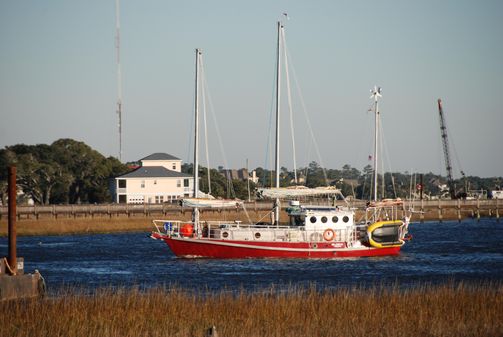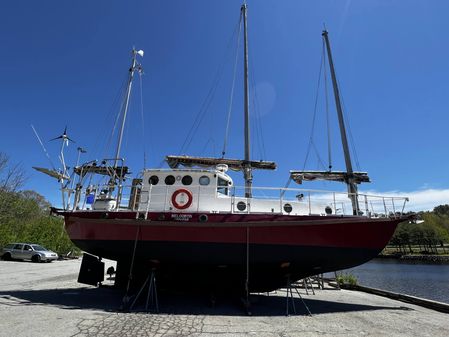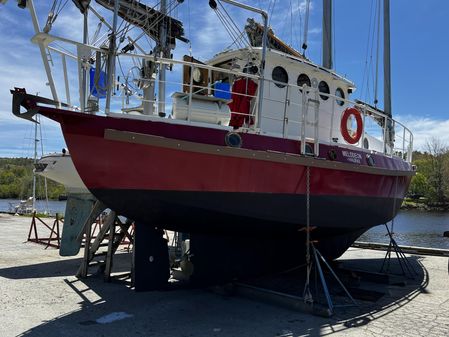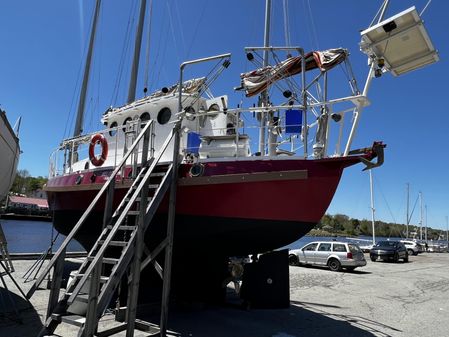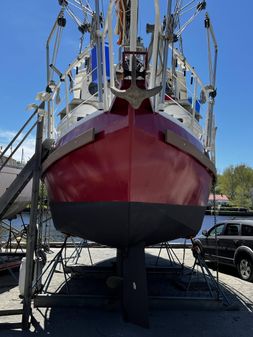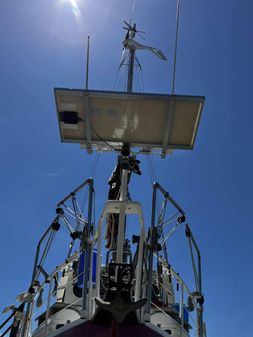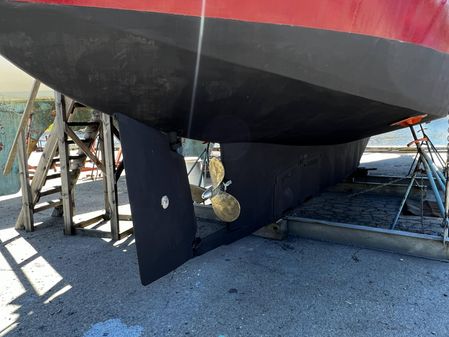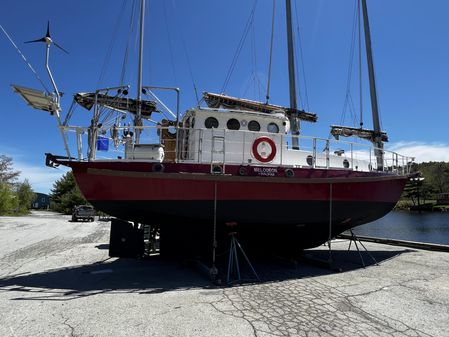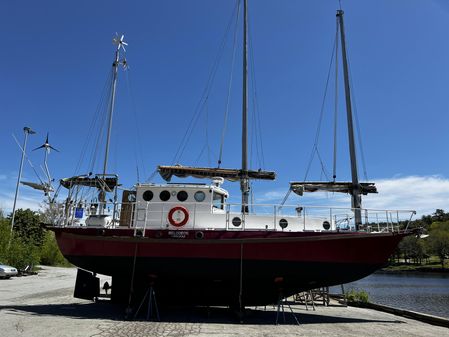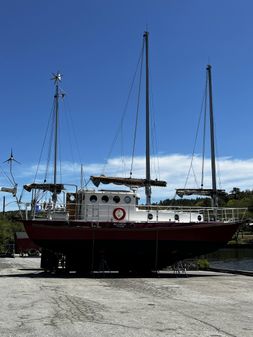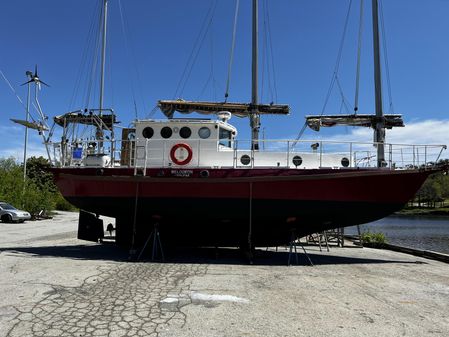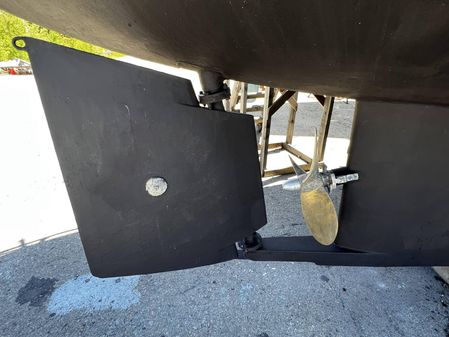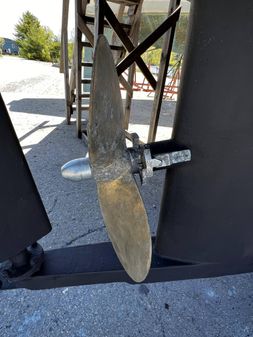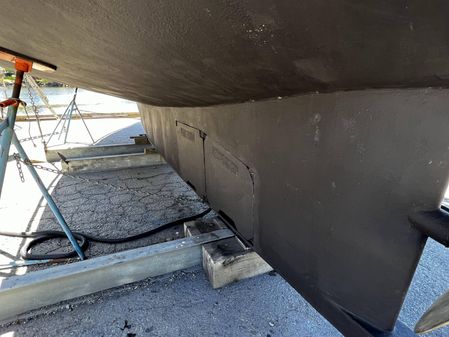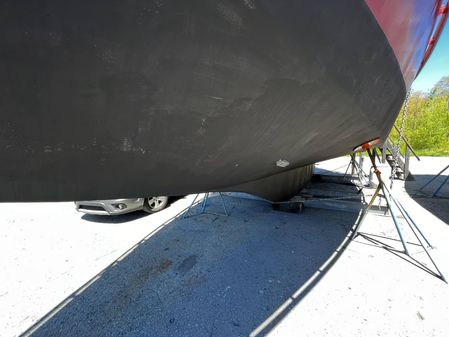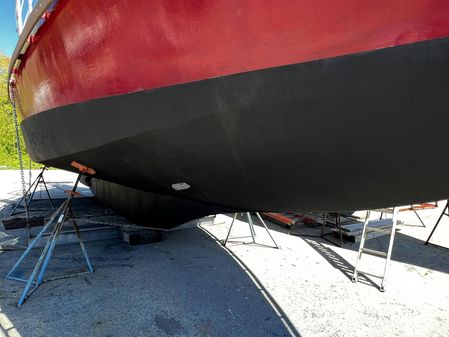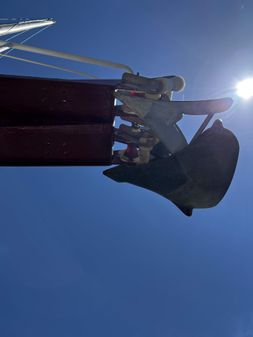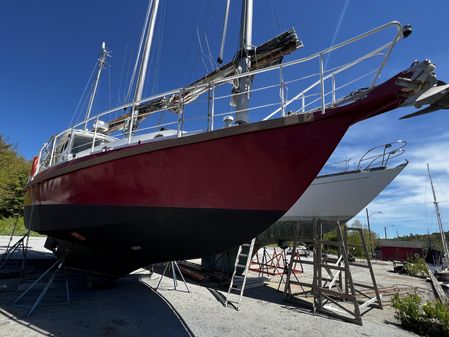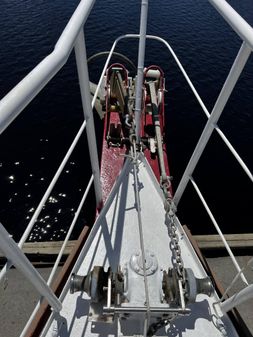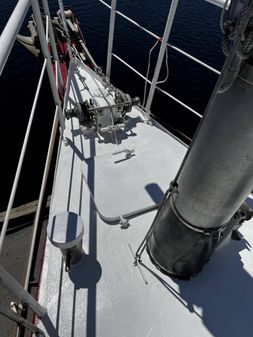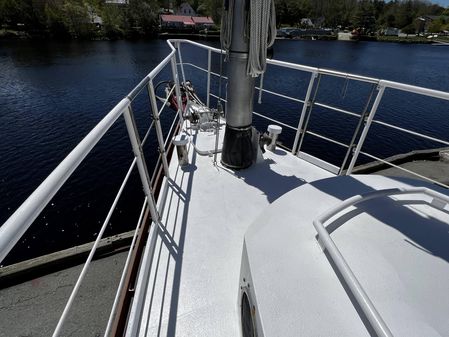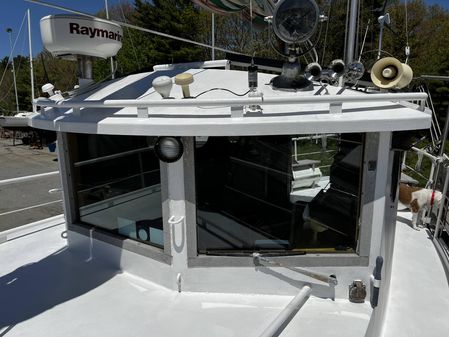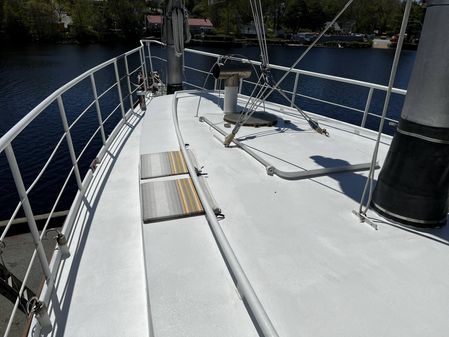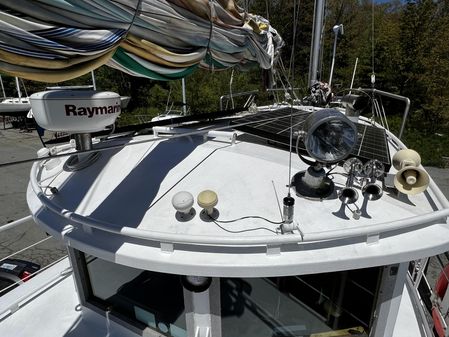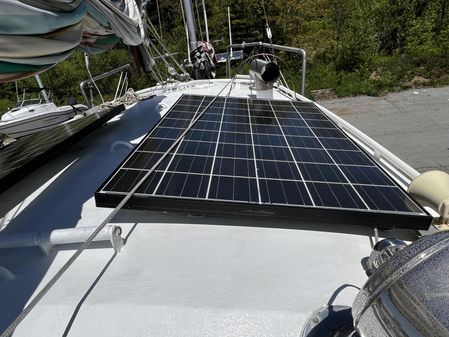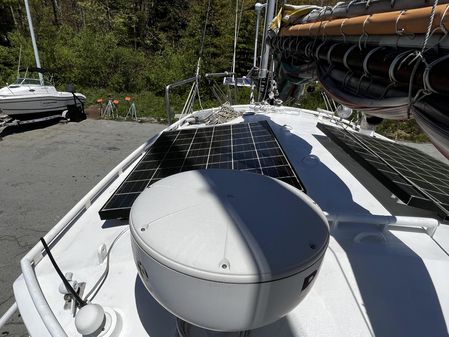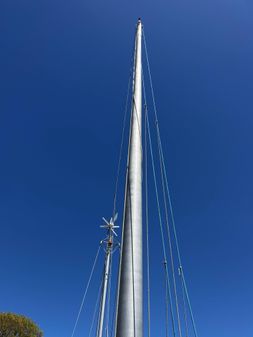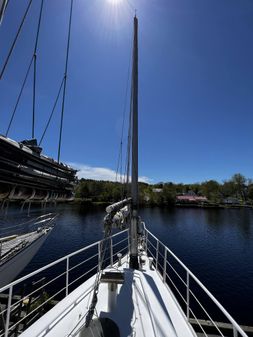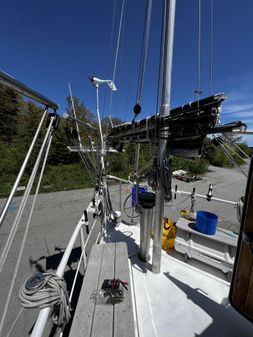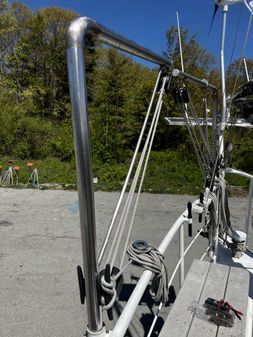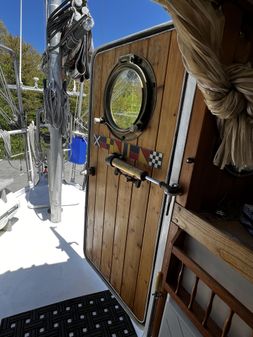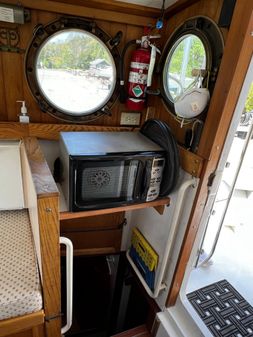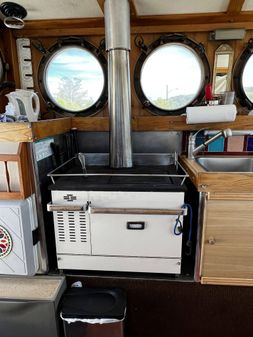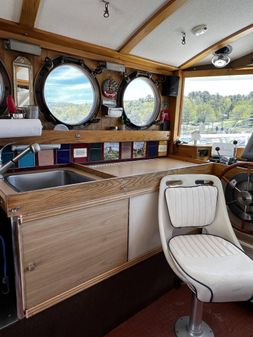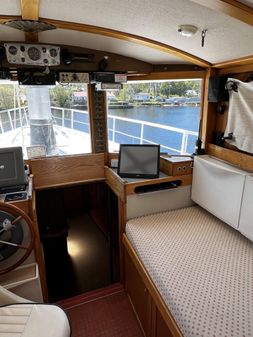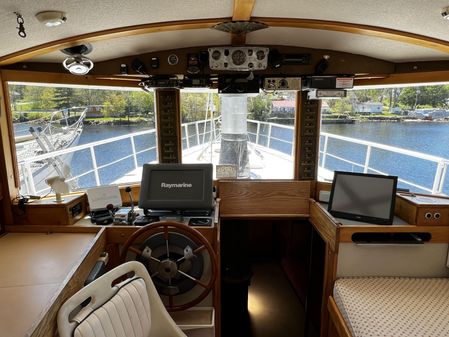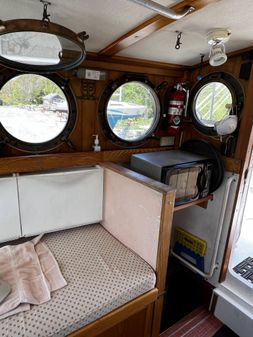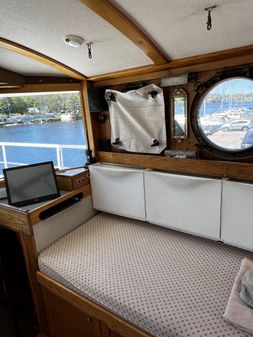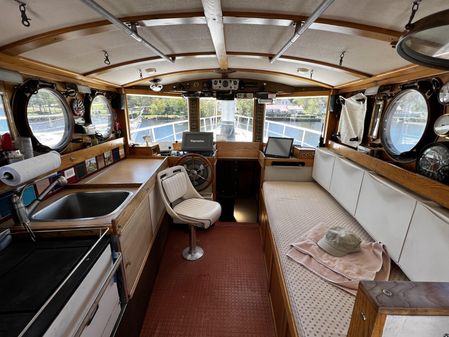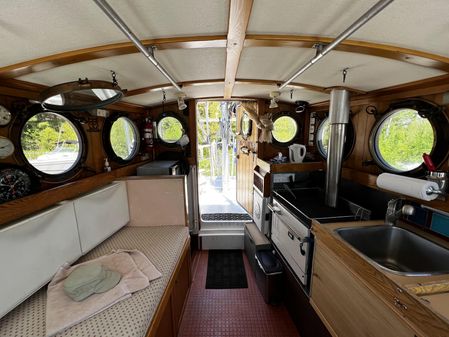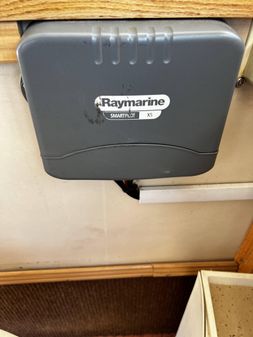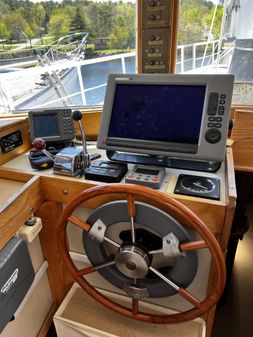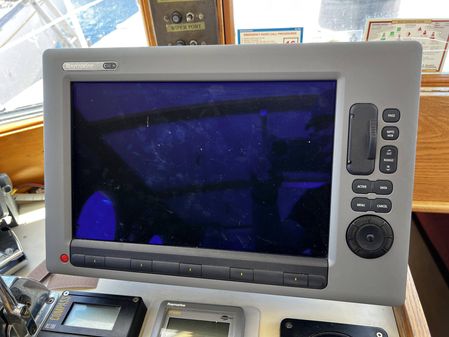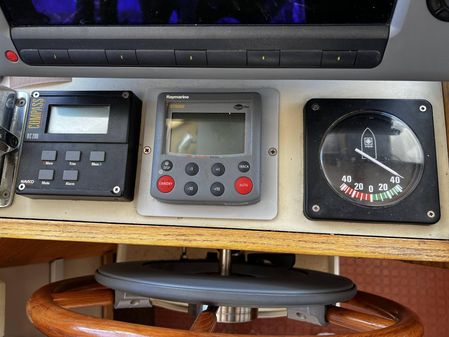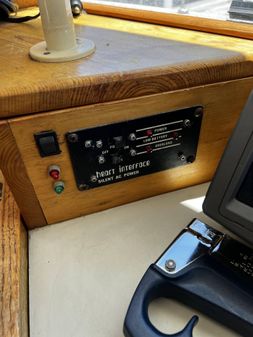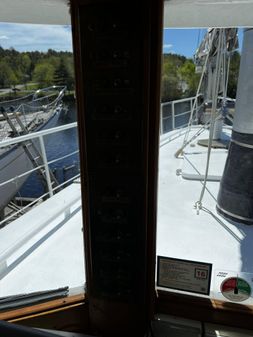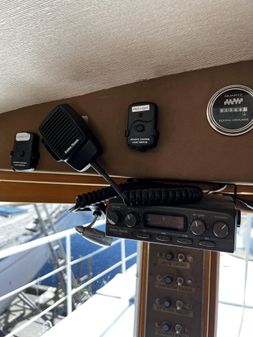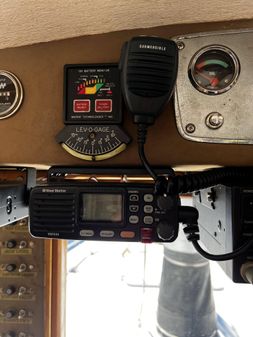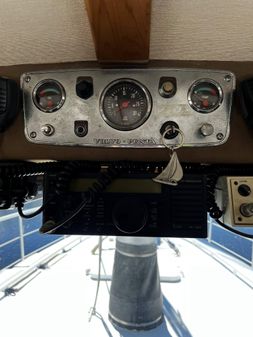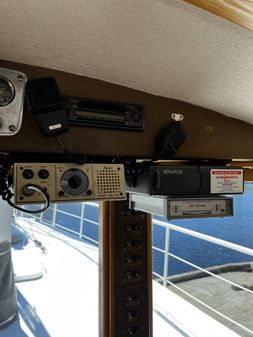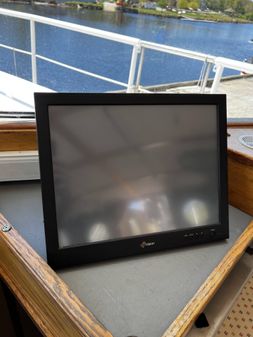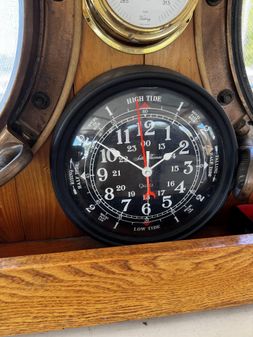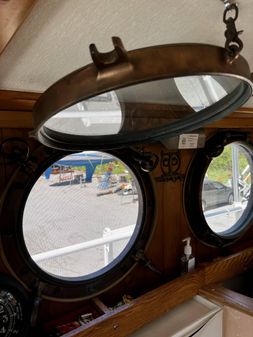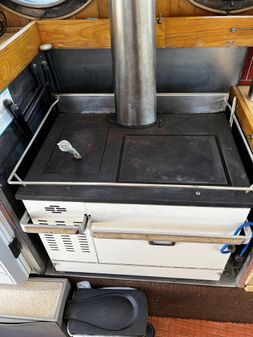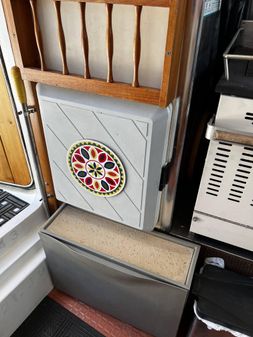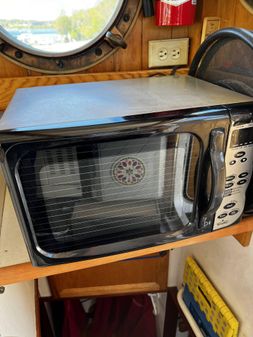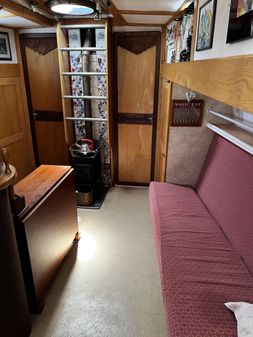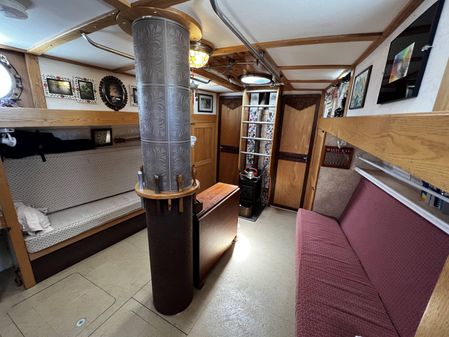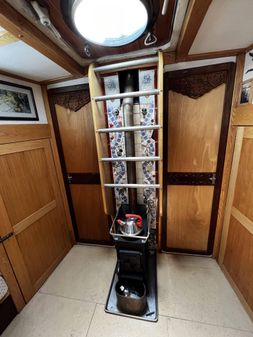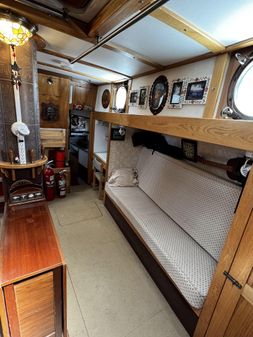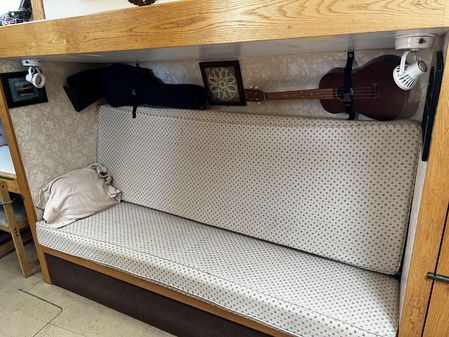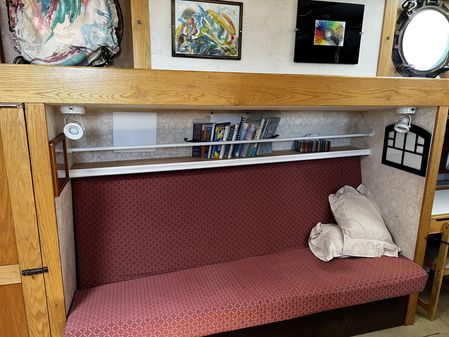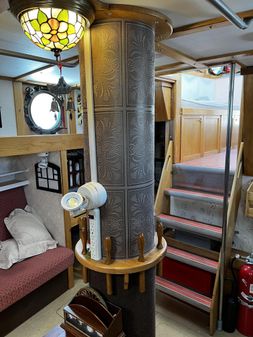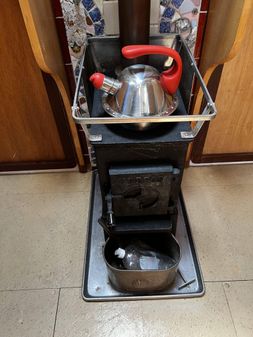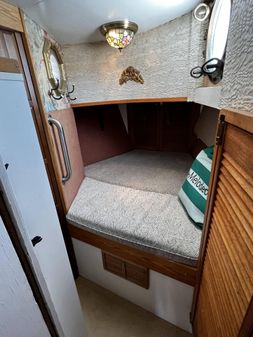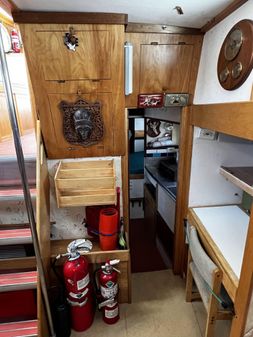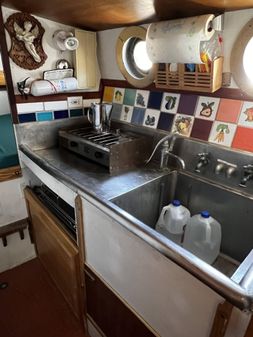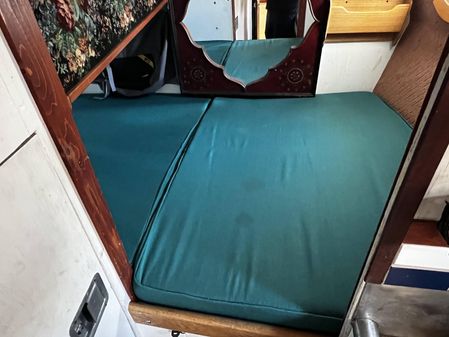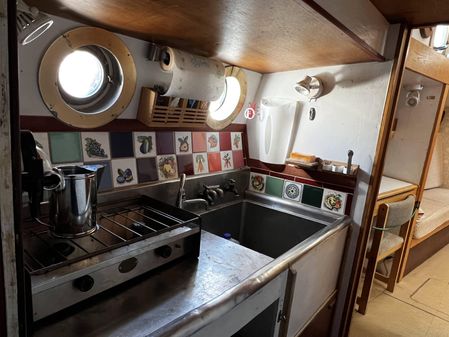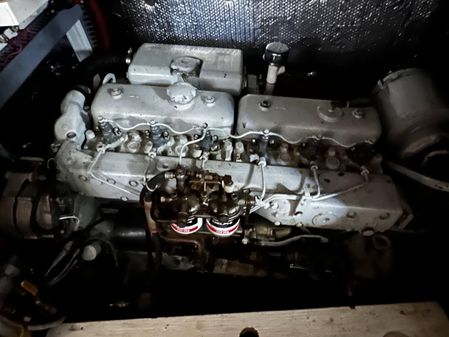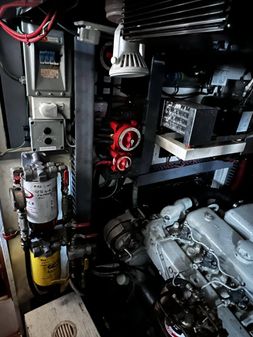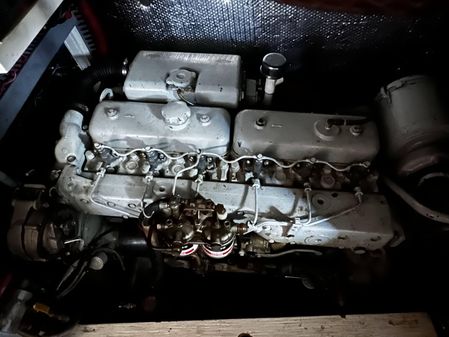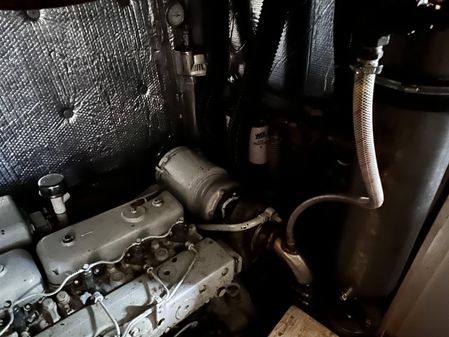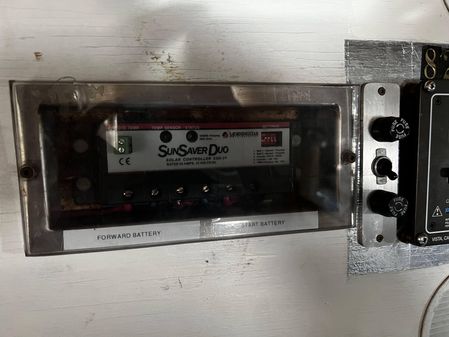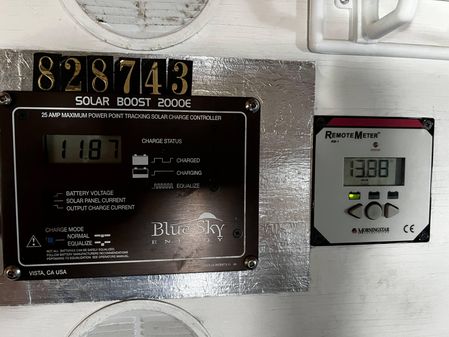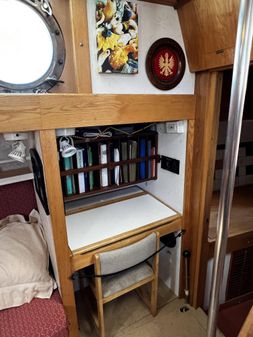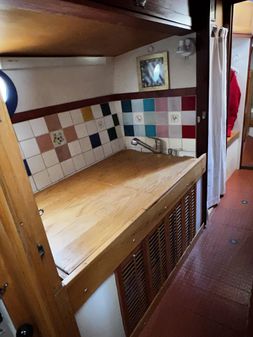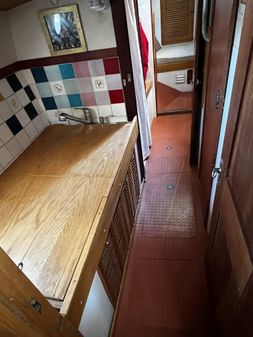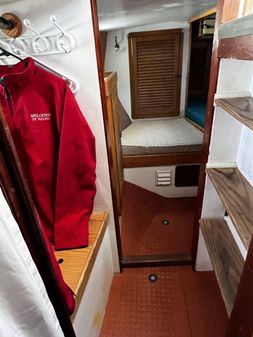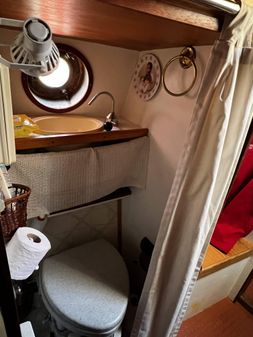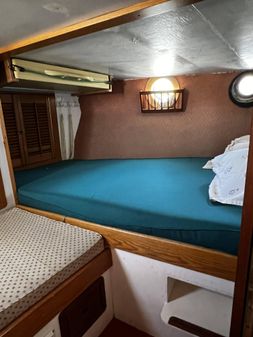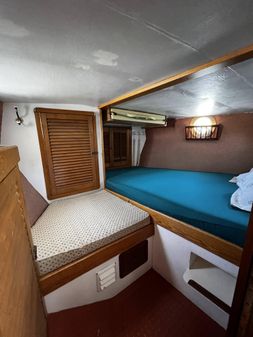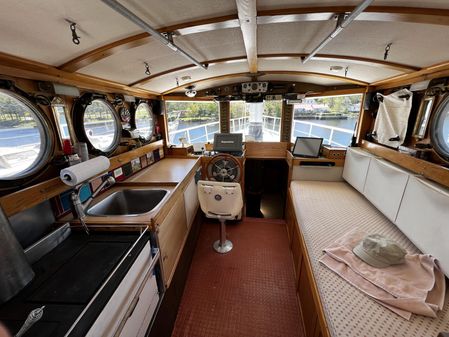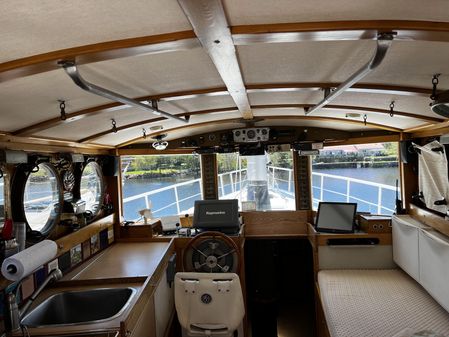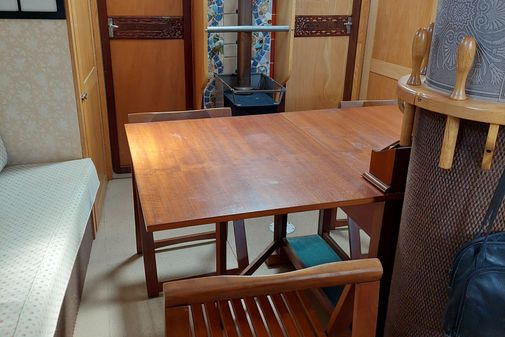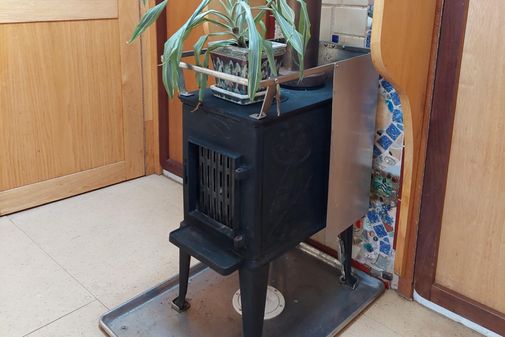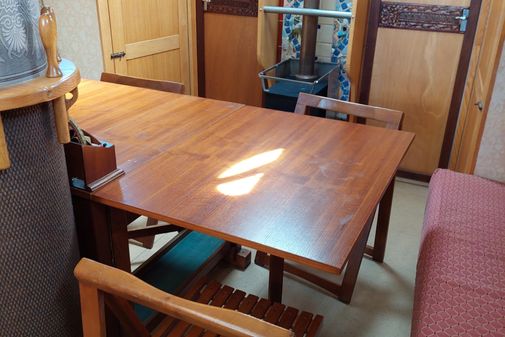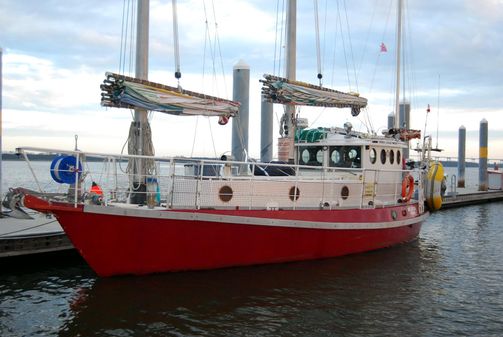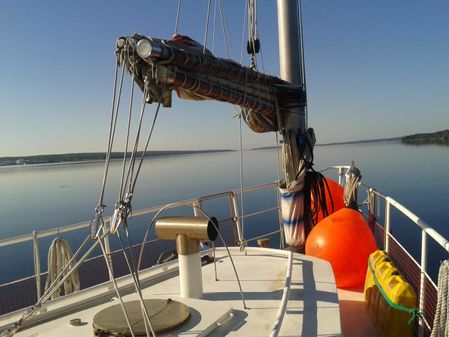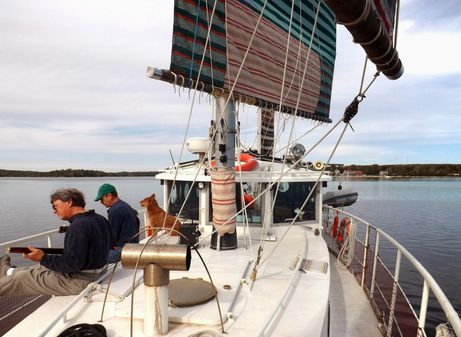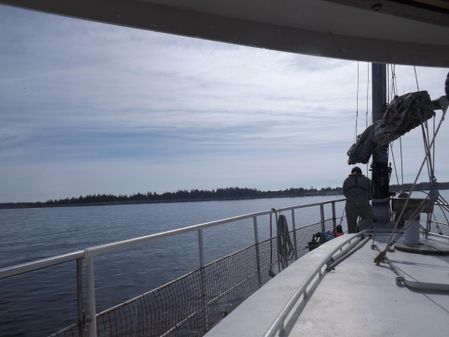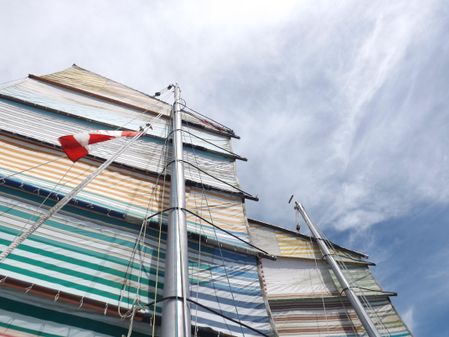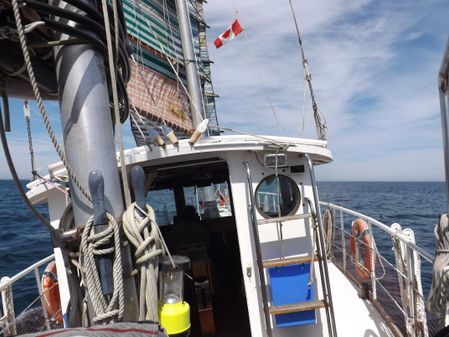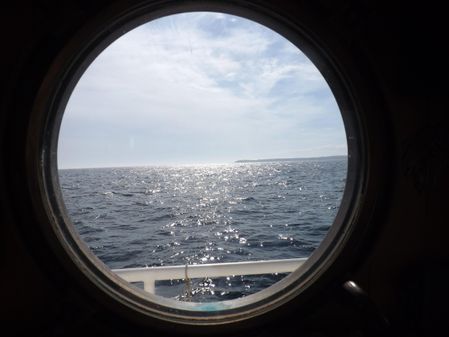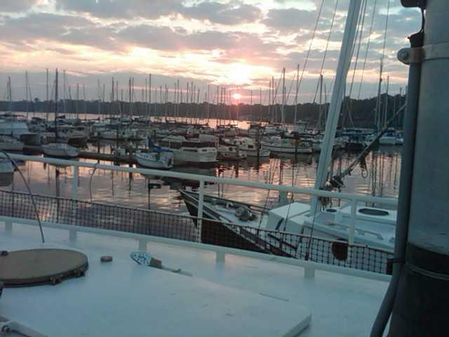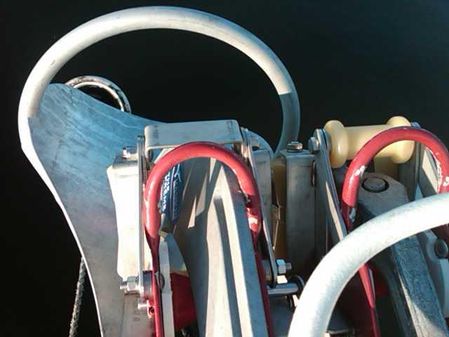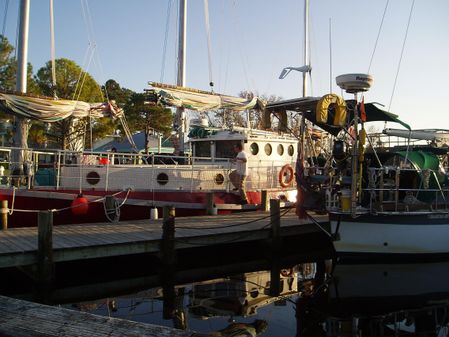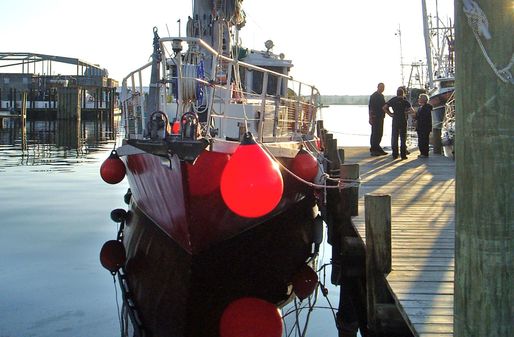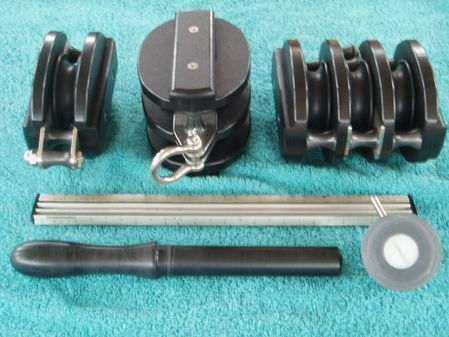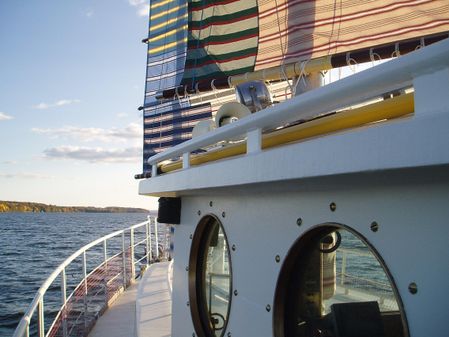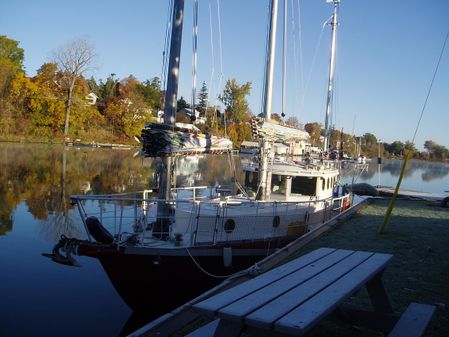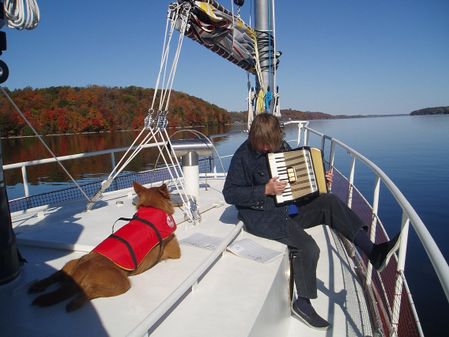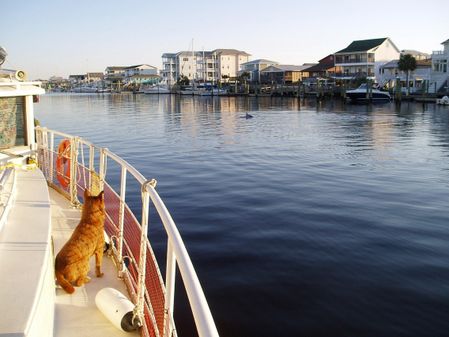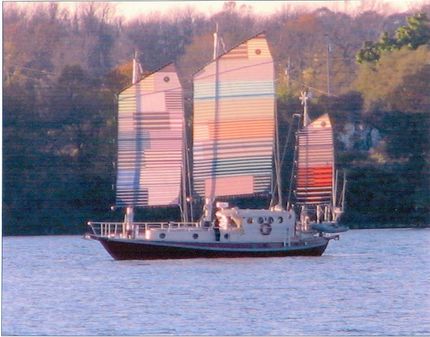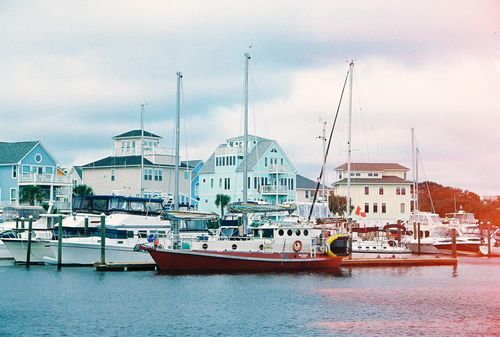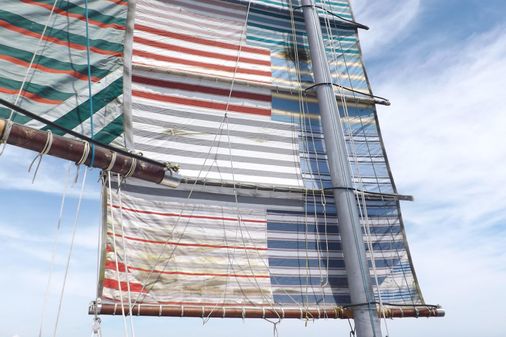Basic Boat Info
Dimensions
Engines / Speed
- Make: Volvo Penta
- Fuel: Diesel
- Engine Power: 200hp
- Type: Inboard
- Propeller Type: 3 Blade
- Engine Location: Center
- Drive Type: Direct
Other
Contact
Office
4425 Hwy 3
Chester, NS, CA, B0J 1J0
Tel:902-593-1280
The Company offers the details of this vessel in good faith but cannot guarantee or warrant the accuracy of this information nor warrant the condition of the vessel. A buyer should instruct his agents, or his surveyors, to investigate such details as the buyer desires validated. This vessel is offered subject to prior sale, price change, or withdrawal without notice.
MELODEON
Melodeon is a custom designed Motorsailer. The hull design is based on a Tucker 43 expanded to 52’ LOD.
The hull, deck and superstructure are all steel, and the welding was performed by certified welders.
Professional architects, engineers and trades people were consulted during all phases of construction, and Lloyd’s and ABYS standards were observed.
In order to improve on systems that are common on pleasure boats but subject to excessive wear, damage or failure, the following areas were addressed:
Thru hull fittings
There are no thru hull fittings. Sea water is brought into the boat through the top of a standpipe that extends above the waterline. If a valve or hose failed, no water would enter the boat. The sea water is used only for exhaust cooling. The exhaust is stainless steel with rubber couplings and can run without water if necessary.
Keel Cooler
The engine does not take in seawater for cooling. There are pipes enclosed by removable plates in the keel that contain an antifreeze mixture. This is circulated through the engine heat exchanger and provides enough capacity to cool the engine even when it is running out of the water. A slot in the bottom of the ¾” keel plate allows for seawater circulation and provides a safe place for dual depth sounder transducers.
Steering
There are two hydraulic variable output helm pumps, one in the pilothouse and one in a pedestal on the aft deck. They work independently and are joined at a manifold that leads to twin hydraulic cylinders attached to the steering quadrant. A combination of valves allows any component to be isolated and the steering will still function.
The rudder shaft log extends above the waterline and would not be a problem even if the internal seal failed. The balanced rudder is massively constructed and fully protected by the keel.
Shaft bearings and seals
There are no conventional cutlass bearings and packing glands. Custom bronze bearings and lip type seals are used on both ends of the shaft log, which is filled with waterproof grease. There are no water leaks or noticeable wear with this system.
Thrust Bearings
A custom designed 1800# thrust bearing assembly transfers the for and aft thrust to the hull. The engine is rigidly mounted to the engine bed and is isolated electrically and from vibrations to the hull. A short driveshaft with universal joints connects the transmission to the propeller shaft. No thrust is transferred to the transmission or engine bed.
Junk Sails and Rigging
The Junk rig was chosen for ease of sailing, durability and maintenance. The fore and main masts are 10” dia. aluminum extrusions, mounted inside steel pipes that are welded to the deck and keel. They are clamped by bolts at the bottom and wedges at deck level. They are not stayed, leaving the deck unobstructed, are sealed at both ends, and contain no electrical wires. The aluminum mizzen mast is stayed and contains wiring for anchor and strobe lights and an antenna for the Short Wave/SSB radio.
The sails are balanced with 25% forward of the mast and have 6 panels individually battened and controlled by a continuous sheet. These sheets terminate at the back of the pilothouse and can be adjusted without going forward. There is no heavy boom required, but the boom on this rig was designed to duplicate the yard in case the yard was damaged. All booms and yards contain spare battens internally. The shell blocks and belaying pins were custom designed and require no maintenance.
MELODEON: Technical Features
Melodeon is a custom designed motor sailor, with a three masted schooner Junk rig. The double ended hull design is based on a Tucker 43 expanded to 47’ LOD.
The hull, deck and superstructure are all steel, and the welding was performed by certified welders.
Professional architects, engineers and trades people were consulted during all phases of construction, and Lloyd’s and ABYS standards were observed.
In order to improve on systems that are common on pleasure boats but subject to excessive wear, damage or failure, the following areas were addressed:
Thru Hull Fittings
There are no thru hull fittings. Sea water is brought into the boat through the top of a standpipe that extends above the waterline. If a valve or hose failed, no water would enter the boat. The sea water is used only for exhaust cooling. The exhaust is stainless steel with rubber couplings and can run without water if necessary.
Keel Cooler
The engine does not take in seawater for cooling. There are cooling pipes accessible by removable plates in the keel. The pipes contain an antifreeze mixture that is circulated through the engine heat exchanger and provides enough capacity to cool the engine. A slot in the bottom of the ¾” keel plate allows for seawater circulation and provides a safe place for dual depth sounder transducers.
Steering
There are two hydraulic variable output helm pumps, one in the pilothouse and one in a pedestal on the aft deck. They work independently and are joined at a manifold that leads to twin hydraulic cylinders attached to the steering quadrant. A combination of valves allows any component to be isolated and the steering will still function.
The rudder shaft log extends above the waterline and would not be a problem even if the internal seal failed. The balanced rudder is massively constructed and fully protected by the keel.
Propeller: The propeller is a bronze, 3 blade, left-handed 26x24”. It is protected by a massive skeg keel extension and includes a custom cable/rope cutter.
Shaft Bearings and Seals
There are no conventional cutlass bearings and packing glands. Custom bronze bearings and lip type seals are used on both ends of the shaft log, which is filled with waterproof grease. There are no water leaks or noticeable wear with this system.
Thrust Bearings
A custom designed thrust bearing assembly transfers the fore and aft thrust to the hull. The engine is solidly mounted to the engine bed with polymer pads and bushings, which isolate it from vibrations to the hull. The engine is also isolated electrically from the hull. A short driveshaft with universal joints connects the transmission to the propeller shaft. No thrust is transferred to the transmission or engine bed.
Junk Sails and Rigging
The Junk rig was chosen for ease of sailing, durability, and maintenance.
Masts: The fore and main masts are 10” dia. aluminum extrusions, mounted inside steel pipes that are welded to the deck and keel. The masts are clamped by bolts at the bottom and wedges at deck level. They are not stayed, leaving the deck unobstructed. The masts are sealed at both ends for buoyancy and contain no electrical wires. Maximum height of the main mast is 50 feet from the water line, allowing passage under lower bridges.
The aluminum mizzen mast is stayed and contains wiring for anchor and strobe lights and an antenna for the Short Wave/SSB radio.
Sails: The sails are balanced with 25% forward of the mast and have 6 panels individually battened and controlled by a continuous sheet. These sheets terminate at the back of the pilothouse and can be adjusted without going forward. There is no heavy boom required, but the boom on this rig was designed to duplicate the yard in case the yard was damaged. All booms and yards contain spare battens internally. The shell blocks and belaying pins were custom designed and require no maintenance.
Sail Handling: In operation the junk rig is easy for two people to handle and can be single handed if necessary. The boat does not have to be turned into the wind to set or reef the sails. Each sail can be raised or lowered effortlessly from one to six panels to match wind conditions. When sailing upwind or on the beam, just turning the wheel to the new course will gently shift the sails to the other tack. Downwind, an accidental jibe will do no harm because of the balanced sails, light boom, and continuous sheet ropes. The booms are above head height and the sails do not obstruct vision under any conditions.
Hull speed: The boat can sail at 7 plus knots under modest conditions. The motion is very comfortable under most conditions and the amount of heel is rarely more than 5-6 degrees. The double-ended hull is favorable for following seas, making the boat seakindly and producing very little wake.
Fuel System
There are three stainless steel fuel tanks, two working and one reserve. There is a valve system to switch between the tanks and two electric fuel pumps to transfer between tanks. Fuel can be polished by transferring through the primary filters. There are two primary filters with clear bowls and valves to switch from one to the other while running. Primary filters can be changed while running, and secondary filters can be bled through a line going to the diesel stove gravity tank.
There are two cross vented filling pipes on deck.
Fresh Water and Wastewater
There are three stainless steel freshwater tanks. They can be filled from a deck fitting with a pressure hose, by gravity, or pumped from a container. The water passes through a filter and an ultraviolet sanitizer when the tanks are being filled. They also pass through the same filters on their way to the fixtures.
There is a 480 gallon per day evaporator type desalinator plumbed into the system that has not been activated.
There is a 110-volt hot water tank that works from engine heat.
There is a grey water tank that is filled by gravity from the sinks and bathtub. An electric pump transfers the water overboard or into the blackwater tank.
The blackwater tank serves a full-size electric macerator head that is flushed using greywater. The tank can be pumped overboard or into a storage tank through a deck fitting using a manual pump.
There is a second Nature’s Head that is self-contained composting.
Deck Features
The deck and superstructure were designed for safety and ease of use under all conditions.
The deck is flush and cannot hold standing water. It is flat with no tripping hazards and is not obstructed by standing rigging or other lines. It has a non-slip coating with painted drains. It is wide enough for two people to pass. There are handrails on the coach roof and the pilothouse. The coach roof provides comfortable seating. Rotating stove pipes prevent downdrafts in the diesel and solid fuel stoves.
Six Opening Gates: There is a three-foot-high steel guardrail with fore, aft and midship opening stainless steel gates on each side. These are useful for docking, going shore and onboarding passengers.
Rubbing Strakes: Full length polyboard planking standing off the hull with stainless steel brackets. Extremely useful for fending off boats and docks, working around the boat, securing safety swim lines and for tying up visiting dinghies.
Safety Swim Ladders: 2 port and starboard plastic, pull down ladders can be deployed by a swimmer or person in the water. They slide to align with the gates on the aft deck.
Dinghy Mounts: There are dinghy davits on the port and starboard side of the aft deck that normally carry two dinghies. Each set of davits has a block and tackle for an outboard motor. One person can launch a dinghy and load an outboard using this system.
Vents: Fuel fillers and vents are on deck, as are vents for sewage tanks and engine room. The three bollards have gasketed adjustable tops for ventilation. The engine air intake is at the back of the pilot house. There is a high-capacity bilge pump below the engine air vent.
Pilothouse Exterior: The pilothouse has an overhang on all sides to prevent the windows from streaking when raining at anchor and allowing the portlights to be open for ventilation.
The front pilothouse windows are 5/8-inch tempered glass. The portlights, with 1/2- and 3/4-inch glass, are salvaged from commercial vessels and can be locked open.
Hatches: There are three watertight hatches, forward over the chain locker, aft over a rope locker, and amidships over the saloon. Hatches have comings, are properly dogged with neoprene gaskets and stainless-steel hinges. A fourth hatch is a large bronze porthole located on the midships cargo hatch. It is useful for ventilation and can hold a 1,200-cfm solar fan for air movement in hot weather and in the storage yard. All can be used for escape if necessary. Access to the pilothouse is by an aft steel door with two-way hinges and a hydraulic damper. There are no sliding hatches.
Deck Boxes: On the aft deck there are two life raft canister deck boxes/seats, one for a life raft, and one to store fuel and oil for the outboard motors. The configuration, combined with a stowable table, create a cockpit alternative seating area.
Outside Helm: There is an aft helm behind the mizzen mast with a stainless-steel binnacle, an 8-inch navy compass, and a stainless-steel wheel attached to a variable pitch hydraulic steering pump. The pump is tied to a similar one in the pilot house. They are joined by a manifold system that leads to twin hydraulic cylinders at the steering quadrant. Any part of the system can be isolated if necessary and the steering will still function.
MELODEON Interior
Pilothouse: with +6.5’ headroom includes:
Helm: Wheel steering position and comfortable chair/standing area port side. Total access to instruments on console and radios on high dash.
Diesel Stove: The Dickinson Marine commercial cookstove which works extremely well with a gravity feed fuel tank adjacent. Adriatic Diesel Cook Stoves | Dickinson Marine It also functions as a boat heater with the assistance of a blower that transfers heat below. There is no propane in boat. Most cooking in pilothouse galley is done electrically, with the energy provided by solar and wind power which charges a battery bank.
Opening portholes: 11 commercial grade bronze portholes, 8 -16” and 3-12” lock open for light and ventilation. The kitchen sink faucet is easily accessible for deck showers on the port side deck.
Settee/Double Bunk: 7-foot settee/pull-out bunk seats a few passengers. It is great for crew naps during heavy seas. It converts the pilothouse to a roomy sleeping cabin for extra hot or cold weather. The second cushion is stowed in the forward cabin.
Table Console: Storage pillar with flip top compartment for cutlery and folding leaves for small meals or food serving. Located in amidships, in front of the sink, with ample room to work at the sink. (Not installed at this time.)
Kitchen and Nav. Storage: 4 Ikea compartments line the starboard side behind the settee are used for logbooks, dish storage, and daily maintenance items. They snug down for rough weather.
Floor Coverings: The entire boat has Armstrong Commercial non-slip rubber flooring, terra-cotta in the pilot house and cabins, ivory in the main saloon.
Privacy panel: Used to divide the companionway to the main saloon, for separate use of both areas, while at anchor.
Main Galley: Large deep stainless sink, between stove and fridge. Pilothouse galley has good view, light, ventilation, and socializing.
Ladder: aft starboard ladder allows quick access to rear head and aft cabin. This pop-down feature has controlled access for visitors.
Refrigerator/Freezer: large, 11cf, well insulated top loading with a 12v Frigomatic compressor. Locks down easily for rough passage.
Microwave/Convection Oven: Combination oven allows microwaving or baking.
Hydraulic Helm: with Raymarine SMARTPILOT x5 Autopilot.
Inverter Controls: Mounted on the dash to turn the inverter on and off.
Switches: Dash mounted, fused switches to control lights, navigation, and communication instruments.
Electronic Equipment: VHF, CB, HF/SSB Icom radios, Pactor Modem SCS PTC-Husb DSP Multimode PACTOR-Controller (for example SCS PACTOR MODEMS - White Squall Consulting Inc.) for weather fax and email over the Shortwave Radio, 2 way Hailer for foredeck anchoring contact, Kenwood KRC-S205 Stereo with 6 CD changer, Raymarine Chart Plotter, Raymarine Digital Radar, Depth Sounders (2), AIS, Flux Gate Compass, Rudder Center Indicator, and Raymarine SMARTPILOT x5 autopilot.
Electrical Systems:
3 solar panels totaling 543 watts, 2 wind generators totaling @ 500 watts, 8 six-volt batteries rated at 950 amp hours total, 2000 watt Heart inverter, 120 amp alternator, 50 amp marine battery charger, and a 30 amp shore power plug.
There are 120 GFI receptacles and energy efficient bulbs and lights including LED, fluorescent, halogen and night vision lights throughout, according to the need.
Charge controllers for solar panels are in Galley 2, midships.
Below Decks
Main Saloon: which is 9’x12’ includes:
Companionway Stairs are designed for safety and ease of use, including a full pole handrail. Stairs and front panel remove for engine access. Pop-down ladder still provides access below decks.
Grab Bars/Handholds throughout including pilot house.
Dining Table: Drop leaf teak table, storing 4 folding teak chairs. The saloon seats 8-12 with settees and desk chairs.
Ulefos Wood Stove: Norwegian low-clearance stove designed for boats is useful for cold damp nights. https://woodburningrocketstove.com/2021/03/04/ulefos-868-classic-cast-iron-wood-burning-stove-black-finish-top-flue-exit/
Long Settees/Storage: 2 settees are excellent for large meals or gatherings. They have hidden lee cloths for rough seas and can be used as (4) bunks. Full storage under.
Desks: 2 pt/sd for navigation and office, with storage compartments and chairs.
Storage Closets: 2 large pt/sd floor-to-ceiling storage cabinets, excellent for food and general storage. One closet contains a large solar ventilation fan and a manual pump for sewage.
Portlights: 4 opening portlights plus large opening portlight overhead in the cargo hatch. Perfect for ventilation and communication.
Ladder to deck: stainless steel ladder over stove, leading to overhead portlight exit.
Electrical Panels: Access to electrical panels, at entrance to engine room.
Batteries: House Batteries: 8-6v deep cycle batteries secured in fiberglass lined boxes under floor and in the engine room, accessible by removable companionway stairs and wall panel. Cranking battery, 4D. Electric anchor winch 4D, in forward cabin.
Tanks: Fuel, fresh water, grey water and sewage tanks and storage, under floor.
Doors: 4 doors leading to 1. forward cabin, 2. forward head, 3. engine room/galley, crew cabin, 4, aft changeroom/head and aft cabin.
Forward Cabin: Large double bunk. Extra ventilation and emergency exit through chain locker. Closet and Ikea storage bins. Large under bunk storage compartments. Large opening portlight. Ensuite door to head.
Forward Head: Electric macerator toilet, sink, storage cupboard, storage cabinet and broom storage. Head is accessed through the main saloon.
Midships Cabin/Galley 2: Double bunk with opening port and storage. Machinery under, including hot water tank, cold water tank, water intake stand-pipe and desalinator. Emergency Exit from bunk into starboard passageway.
-Galley 2: Large commercial stainless-steel sink and counter, hot water, and storage. Opening portlight. Force 10 Marine, 2 Burner kerosene/diesel cook stove is portable to deck for outdoor cooking. Access to engine room. Easy access to water system manifolds under floor. Charge controllers for solar panels.
Engine room
Engine room is fully insulated and very quiet. It is fully accessible from both sides, in Galley 2 and the Dressing Room Passageway. Access is through easily removable, hinged insulated panels that rest in the Main Saloon when removed.
Volvo Penta, TMD70-AB 200hp diesel engine.
Borg Warner Velvet Drive transmission.
Twin alternators, 60 and 120 amp., electrically isolated from hull.
50-amp marine battery charger.
Galvanic isolator.
Twin switchable fuel filters.
Twin oil filters.
8 6v deep cycle batteries
High current fuses for all batteries, transfer switches.
Switches for wind generators.
12v refrigeration compressor.
Dressing Room Passageway and Second Head
Three doors in starboard passageway separate and enclose:
4’ Bathtub with hand shower and wooden cover. Doubles as life preserver storage and child’s berth. Clothes drying area. More storage under.
Head 2: Nature Head, 2 function, #1 urine tank safe to empty and composting toilet. Hand sink. This toilet is invaluable and super accessible to the helm for long hard passages, via the pop-down ladder.
Hanging wet locker and boot storage. Storage under.
Storage under floor panels.
Panels remove to access engine, drive shaft, thrust bearings
Aft Cabin
Double bunk is an extremely comfortable lounge area, with carpeted walls. Large storage compartments under. Close to the helm for communication underway.
Opening portlight.
Privacy door.
Settee/Reading nook with storage.
Two ample closets.
Storage under floor.
Steering components in compartment under bunk.
Ceiling mounted plastic 4- person picnic table for shore parties.
Extra ventilation and emergency exit through stern locker.
Stern Locker is large enough to store 2 small folding bikes or other equipment.
-----
MELODEON: Overview and Options
If the motor sailor Melodeon is anything, she is versatile. She has many faces and possibilities for her new owners.
This boat has proven her fabulous capabilities and functioned extremely well as a sailing, cruising live-aboard boat.
Wherever she is Melodeon is a boat that draws attention due to her interesting aspects and colorful harlequin junk-sails. She has been captured for the evening news a few times by the weather helicopter she visits a new port. She has also been the popular subject of harbor cams and news articles as she travels.
Melodeon can also double as a 3-bedroom home or unique cottage in any city by the sea. With skyrocketing real-estate prices and poor availability, she can become an affordable home that can go for a sail on the weekend.
For someone who wishes to run a high-profile business in a busy harbor, she is roomy enough to host staff and clients in a novel setting.
Melodeon is also the toast of the dock or anchorage if someone has an interest in entertaining. Many dinghies can tie up on her rubbing strakes and her upper deck is able to host an entire band, for a dock party or raft-up.
Other options for her, besides sailing the ocean blue, include hosting weddings (she has one under her belt), B&B guests, special meals, spa retreats, family gatherings and seminars on any topic.
With her high rails, rail nets (not shown) and other safety features, Melodeon is relatively safe for kids and pets. The unstayed masts allow easy movement and the huge coach roof seats many guests on comfortable, waterproof cushions.
Finally, it should be noted that Melodeon is well insulated and comfortable in extreme temperatures. The ease of sailing and seaworthiness are fantastic.
This is an eye-catching little ship, that is easily handled by 2 people. Be prepared to meet new admirers or keep your curtains up dockside if you become her new owner.
The Company offers the details of this vessel in good faith but cannot guarantee or warrant the accuracy of this information nor warrant the condition of the vessel. A buyer should instruct his agents, or his surveyors, to investigate such details as the buyer desires validated. This vessel is offered subject to prior sale, price change, or withdrawal without notice.

